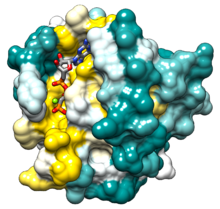 | |||||||||
| Identifiers | |||||||||
|---|---|---|---|---|---|---|---|---|---|
| Symbol | Ras | ||||||||
| Pfam | PF00071 | ||||||||
| InterPro | IPR013753 | ||||||||
| PROSITE | PDOC00017 | ||||||||
| SCOP2 | 5p21 / SCOPe / SUPFAM | ||||||||
| CDD | cd00882 | ||||||||
| Membranome | 206 | ||||||||
| |||||||||
The Ras superfamily, derived from "Rat sarcoma virus", is a protein superfamily of small GTPases.[1] Members of the superfamily are divided into families and subfamilies based on their structure, sequence and function. The five main families are Ras, Rho, Ran, Rab and Arf GTPases.[2] The Ras family itself is further divided into 6 subfamilies: Ras, Ral, Rap, Rheb, Rad and Rit. Miro is a recent contributor to the superfamily. Each subfamily shares the common core G domain, which provides essential GTPase and nucleotide exchange activity.
The surrounding sequence helps determine the functional specificity of the small GTPase, for example the 'Insert Loop', common to the Rho subfamily, specifically contributes to binding to effector proteins such as WASP.
In general, the Ras family is responsible for cell proliferation: Rho for cell morphology, Ran for nuclear transport, and Rab and Arf for vesicle transport.[3]
- ^ Wennerberg K, Rossman KL, Der CJ (March 2005). "The Ras superfamily at a glance". J. Cell Sci. 118 (Pt 5): 843–6. doi:10.1242/jcs.01660. PMID 15731001.
- ^ Goitre, L; Trapani, E; Trabalzini, L; Retta, SF (26 December 2013). The Ras superfamily of small GTPases: the unlocked secrets. Methods in Molecular Biology. Vol. 1120. pp. 1–18. doi:10.1007/978-1-62703-791-4_1. ISBN 978-1-62703-790-7. PMID 24470015.
- ^ Cite error: The named reference
Munemitsuwas invoked but never defined (see the help page).